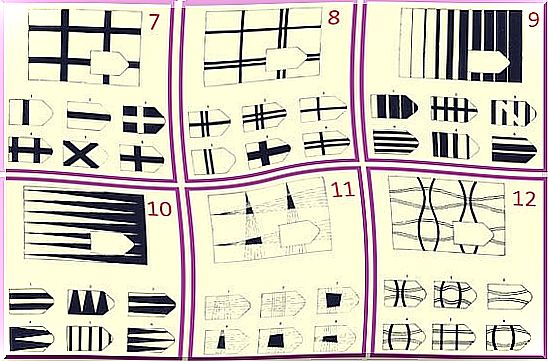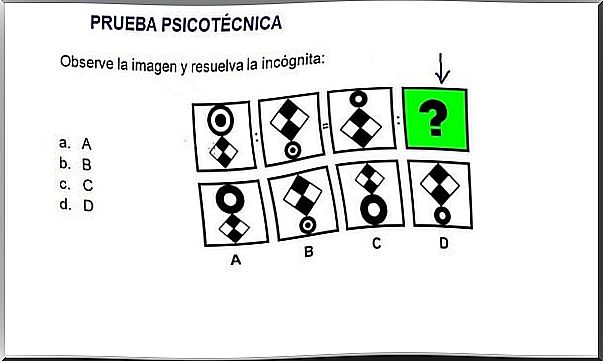Raven’s Progressive Matrices Test, What Is It For?

Raven’s progressive matrix test is one of the most widely used instruments to measure analog reasoning, the capacity for abstraction, and perception. Thus, its 60 questions allow us to evaluate the intelligence “g” factor proposed by Spearman, those more general mental and cognitive processes where we usually give more or less effective answers to everyday problems.
Let’s admit it, most of us have been handed this instrument from time to time. It is usually applied on a regular basis in educational centers and in personnel selection tests. Likewise, today it is also common for it to be part of the psychotechnical tests in the selection processes for different professions.
Given its application contexts, it is possible that we often view this test with some discomfort, as that known enemy that has been a challenge at different times in our lives, whether for academic or work reasons. However, there are also those who view Raven’s progressive matrix test with deep interest because they enjoy solving those little enigmas, where to identify patterns, where to solve series, where to infer, where to refine perceptions and abstractions …
Be that as it may, there is something that is clear. The measurement of IQ (intelligence quotient) continues to be clearly valid today and in most of our contexts. Regardless of whether or not we accept Howard Gardner’s theory of multiple intelligences , on a day-to-day basis, that unitary vision of intelligence is given much more priority, where to measure in the human being their capacities for logical reasoning, problem solving or critical thinking.
Raven’s progressive matrix test is an example of the latter, where we measure abstract reasoning and that fluid intelligence that Cattell told us about at the time and that allows us, after all, to solve the most everyday problems. Perhaps in the future things will change and the psychotechnical tests will be articulated in a different way.
However, it must be said that this type of instrument is not without its interest and above all its usefulness. Let’s see it in detail.

Raven’s Progressive Matrices Test, what is it for?
The Progressive Matrices test was created by JC Raven in 1938 to measure the “g” factor of intelligence. The design of this psychometric test sought one objective: to evaluate the officers of the US Navy. However, it did not take long to see its usefulness and validity to assess intelligence in general regardless of the knowledge acquired.
Benefits of the Raven Progressive Matrices Test vs. Other Tests
- It can be applied to children and adults, regardless of their cultural level or if the person has communication or motor problems.
- It is a very economical test to administer.
- In general, it is interesting and entertaining for most people (there is involvement and motivation).
- It requires “gestalt” attention as well as analogical reasoning where the person must apply an exploratory behavior, another comparative one and use several sources of information at the same time to complete the matrices.
Likewise, one of the greatest benefits of the Raven Progressive Matrices Test is the speed with which we obtain valid information about the cognitive functioning of the adult or child.
On the other hand, something important must be said. The creator of the test himself, John Raven, made it clear that. Other sources of information should be provided, so that the evaluation can be much more powerful and its results more robust.

How the Raven Progressive Matrices Test is Performed
The test is made up of 60 multiple-choice questions, organized in different order of difficulty. They are used, as we already know, a series of abstract and incomplete geometric figures that the person must solve, trying to give meaning to a material at first glance, confused or disorganized.
In general, about 45 minutes are usually allowed for its completion, enough time for the child or adult to put into practice what we know as education capacity. It is a process characterized by the following:
- The capacity for eduction is based on finding relationships and correlates when what we have before us is a type of information that at first glance is disorganized.
- Also, this type of intellectual ability requires that we make comparisons, deductions, mental representations, that we apply analogical reasoning and the principle of logic.
All of this shapes the “g” factor defined at the time by Charles Spearman and which in turn is considered a valid predictor of intelligence in general.

Raven’s Progressive Matrices and the Flynn Effect
Rossi-Casé and her research team (2015) published a study on the Flynn Effect in Raven’s progressive matrices. But what does this effect consist of? In a very summarized way, this effect consists in that with the generation changes our score in IQ tests increases. The explanation for this phenomenon would lie in improved schooling, advances in medicine, proper nutrition, having a rich and varied environment, etc.
Rossi-Casé and her research team (2015) investigated the relationship between Raven’s progressive matrices and the Flynn Effect. The results showed that between 1964 and 2000 the Flynn effect could be appreciated, but it was not as palpable between 2000 and 2015. The authors wonder if this effect will increase indefinitely or stop at some point, and in case of be like this, when. They point out that to answer this question, “we should re-analyze the hypotheses that at the time tried to explain the presence of the Flynn effect, such as improvements in nutrition, more schooling, the use of new technologies and the predominance of visual images. ” .
Undoubtedly, these results evidence the need for future research on Raven’s progressive matrices.
A final note
To conclude, Raven’s progressive matrices test is a non-verbal or manipulative instrument whose scores do not depend on the educational level or experience of that person. All this undoubtedly makes it very interesting, as well as useful for certain contexts where you want to have prior information about the intelligence “in general” of students or candidates for a professional category.
Its ease of application and the low difficulty in obtaining a result from the answers given by the person means that, whether we like it or not, it is very present in most of our social contexts …








